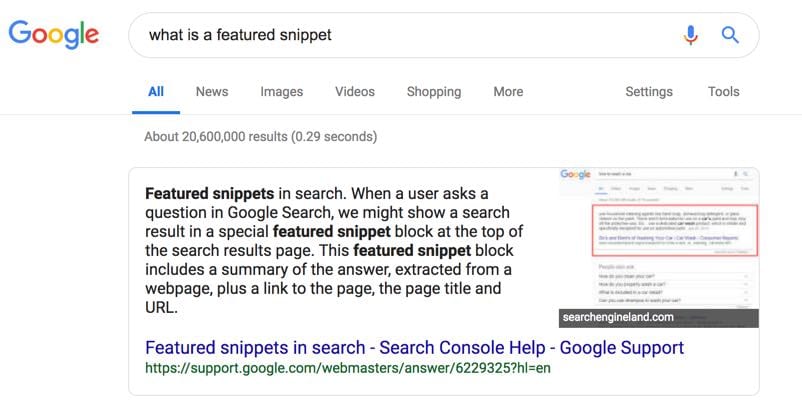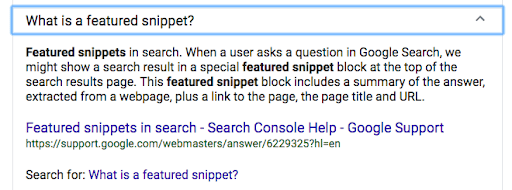Google Featured Snippets: How to Optimize and Why It is Important

Traditionally, the greatest achievement for a website was to rank #1 on search engines. This has changed since Google introduced Featured Snippets.
Within this blog, I am going to show to explain:
- What is Google Featured Snippets
- Why is it important
- and How to Optimize your Content to show featured snippets
Google Featured Snippets Explained

Featured snippets gives you the chance to rank above the #1 organic search result, right below the paid ads.
As the name suggests, snippets contain a small part of the solution to search queries which attempt to answer the searcher without him/her necessarily leaving Google.
They present content in form of paragraphs when the query is on “what/why is,” tables when the query is “how much,” bulleted lists for “how to/does,” queries, and answer boxes for “meaning of.”
These are broken down into four types of snippets:
- Tables
- Lists
- Paragraphs
- Answer boxes
As a web developer or online marketer, you cannot afford to ignore the snippet feature as it is inarguably the leading traffic puller today.
Searchers who find satisfactory answers to their queries from your snippet are more likely to visit your site before any other SERP and to engage with your content.
According to a study by Hubspot:
posts that become featured snippets have a 10.5% increase in clicks.
Websites that rank among the top 10 SERP results have a real chance of being featured in the Google Snippets, although it appears the #1 search result rarely gets that chance. Perhaps Google considers it to be privileged enough with its top ranking.
The secret to being featured lies in attaining the 2nd to the 10th SEO rank.
In this post, we will look at what you should do in order to increase your site’s chances of being featured and improve your site’s SEO.
How Can You Optimize Your Web Content for Featured Snippets

1. Use questions in your content
If your content’s heading and subheadings are questions that people ask often, then you stand a good chance of getting picked by Google as its featured snippet.
You can use Google to help you ask questions. Just start typing in question on Google and pay attention to the autofill feature, which will help you find common questions people ask.
You can also use this great resource: Answer the Public.
Just type in a query and it will generate common questions people ask on search engines for you.
2. Break your content into small, readable chunks
We have mentioned that there are four types of Featured Snippets: Tables, lists, paragraphs, and answer boxes.
All four types have one thing in common, and that is their ease to scan through.
Always organize your content in small and comprehensive paragraphs, break it up with readable bullets, and use tables where applicable.
If you have a lot of data to share, do away with paragraphs and instead display it as a table.
3. Use video
You cannot run away from visual content these days.
Google mostly answers tutorial questions e.g. “how to’s” by displaying tutorial videos as a Featured Snippet.
If you have a solution to a possible “how to” query, post a video of it.
4. Use long-tail keywords phrases
Long-tail keyword searches yield more Featured Snippets than short ones. See how we have cleverly used this strategy… instead of using a simple “Optimizing Featured Snippets” subheading, we have instead used a longer keyword phrase “How to Optimize for Featured Snippets.”
Just like with asking a question using Google as help, do the same for longtail keywords.
Do the same for your site.
5. Leverage high-quality backlinks
To rank well, you need to make sure you have good domain authority. The only way to build authority on your site is to acquire backlinks. Make sure that you have a good backlinking strategy that will help you garner good links.
Creating original content can help you gain more links, and posting on social media can help others find and share your content or stories, gaining more traffic and potential for acquiring backlinks.
Google will earmark authoritative websites that answer search queries from its users.
6. Answer Questions
How many probable search queries can one article contain?
Don’t leave out questions that you can easily answer just to avoid prolonging your article.
The more answers an article has, the more relevant Google deems it to be for its searchers, and the higher its chances of making it to the Featured Snippets.
Create rich content that helps guide the reader through a topic and answer questions that can help the user.
7. Use Factual Data
Don’t use unproven data because people will realize it and ignore your content.
When visitors hurriedly leave your site, it signals Google that your content isn’t helpful to them.
To convince the search engine otherwise, only use data that makes sense to readers.
Make sure you answer the question and answer it well.
Conclusion
So that’s how to optimize for featured snippets.
Trying to get featured snippets does not have to be a difficult process. You just have to make sure that you utilize the resources you have.
Have you acquired a feature snippet? Let me know in the comments!
!function(){var e=document,t=e.createElement(“script”);t.src=”https://www.semrush.com/leadgen/static/js/widget.min.js?v=”+Math.random(),(e.head||e.body).appendChild(t),t.onload=function(){new SEMRUSH.SiteauditWidget({widgetApiKey:”58fbfc235f50e972b39cc7a3″})}}();








